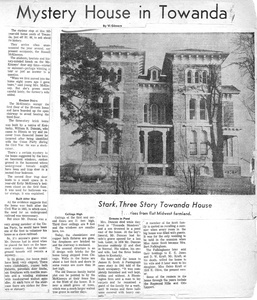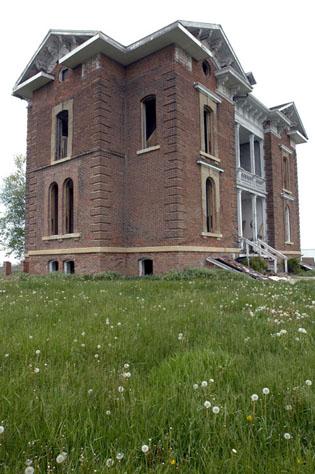Duncan Mansion, also known as Duncan Manor, is one of the first Italianate farm house built in McLean County. The Manor was built around the time of 1869 by a livestock dealer named William R. Duncan, who moved to the Towanda area from Clark County Kentucky in late 1863 during the Civil War. The manor was occupied by Duncan and his family for a few years before he passed away due to an illness in the autumn of 1876. Since then, the house has been rented out to many tenants. One in particular whose name is Ed Rascaille, wrote about his childhood memories in the house, and stated that: "(This house) was one of the 'crane-your-neck and make guesses' landmarks along Route 66."
The house also was a source of vandalism over the years it has been abandoned, it has been listed on the Ten Most Endangered Historical Places in Illinois, and then finally purchased by the Sullivan's in 2008 who plan to restore the house to it's original state.
 Duncan Manor, 2008, before remodeling took place.
Duncan Manor, 2008, before remodeling took place.
About William Duncan
Born on December 15, 1818 in Clark County Kentucky, William R. Duncan didn't have much, but his childhood is uncertain. He married twice, which he ended up as a widower. Finally in November of 1864, Duncan married for his third time to Sarah Bean, who was also from Clark County. While in Kentucky, he grew a reputation for being a breeder of short horned cattle.
Duncan moved to McLean County in 1863 due to financial ruin that was brought on by his "pro-Federal politics." How he came about the money to buy the land which Duncan Manor rests on today is interesting.
After his second wife, Mary Quisenbury, passed away, the land that she owned in Clark County was passed along to her four children. The Clark County Circuit Court ordered that the land had to be sold, and the money be reinvested by Duncan for his children. When the land was sold, he took the $13,500 and purchased 300 acres here in McLean County from Nathaniel Sunderland.
The price of land was forty five dollars an acre along the Chicago and Alton Railway, which was close to the station in Towanda. It was important to Duncan to keep the land in his children's name. When his fifteen year old son died due to drowning in the spring of 1868, Duncan became the heir to his son's share of the land. He sold his claim to the remaining children for one dollar.
Structure of Duncan Manor
The house is built overlooking the railroad, and an old state road which Jesse Fell had established between Bloomington and Towanda. The house faces northwest, and has two towers that are each capped with a bracketed roof.
The towers are three stories high with double light round capped windows on the lower two floors. The main entrance, which is no longer used to to the decrypted state of the house, is located between the two towers. Above the entrance is another triple window that lights the 'monumental' staircase inside.
The first floor contains four rooms and a large central hallway. Located in the central hallway is the grand staircase. The second floor is similar to design as the first. Three bedrooms are accessible to the hall, but the south room is only reached from the kitchen stairs, or the attic above.
The third floor is called the tower room, which have now been finished. Behind the room is an open storage space which the remains of the chimney stacks can be seen.
John Drury, an Old Illinois Houses editor, commented on a feature of a second story 'secret room'. "Another feature of the house which might be connected with the maintenance of negro servants is a mysterious trap door in one of the second-floor bedrooms which lets down into a bare, dark room. Although numerous old Illinois houses. especially in the southern part of the state, have these trap doors leading to secret rooms, the use of this somewhat bizarre arrangement has never been satisfactorily explained." This leads into local lore and legends about the Duncan Manor being a safe house during the Underground Railroad.
Duncan Manor's Urban Legends
"Dark faces peering from behind the barred basement windows," (Steinbacher-Kemp) is just one of the statements that is said about the famous farm house. It is also rumored that the house was a safe house for slaves in Underground Railroad. Rumor has it that when slaves were escaping north towards Canada for freedom, they used this house as a hide out.
What is said to be somewhat true is that the Duncan family had slaves of their own. During the night hours, when they were not working for Duncan and his family, they were chained to iron fastenings in the east room of the basement.
Popular beliefs today though recall people having paranormal experiences at the house; hearing unexplainable noises, flying objects or objects moving on their own, or being touched while there.
The Truth of the Legends
"Aside from the obvious problems of date, and the difficulty (of) a prominent nineteenth century gentleman. with six children, keeping anyone chained in his cellar in secret (was a hard task)."
The 1870 census shows that everyone living in the Duncan house was of European background. This included Duncan's immediate family (wife, and children). an English born herdsman (wife and son) , a nineteen year old maid and gardener, and two Swedish farmhands that helped with Duncan's short horn cattle.
As many people's beliefs still stammer about the truth of the farmhouse being a big part of America's rich history, the Manor being part of the Underground Railroad is just an urban legend. There are many stories about the tunnel from the house to a barn, and a treasure room below a second-floor bedroom that fuel the legend. The secret "room" below the bedroom was no more than a cistern for a first floor bathtub.
The House Today
Regardless of it's folk lore past and many rumors about the house being haunted, Towanda Meadows recognized the Manor as one of the finest farmhouses ever built in Illinois. It's Italianate architectural style has people looking over it from afar. It was not the first Italianate farmhouse in McLean County. The first belonged to Home Park Place, built in 1869 by Nelson Jones, another Towanda Township stockman.
In 2008, Diane and Bud Sullivan purchased the house in March. They claimed bankruptcy in 2011 and the house fell into foreclosure.
During its 140 years of existence, tenants have ignored maintenance and covered up key details to the house. After many years, the house was then left vacant for some time. Vandals harmed the historic nature of the house by taking hammers and destroying windows, one of a kind details to the house, and destroyed parts of the famous staircase.
Lois McKinney, a former tenant of the Manor, lived in the house for fifteen years throughout the 1960's-70's. She recalls the house not having proper insulation; being 'cold as an icebox' in the winter, and baking in the summer. McKinney does state that she never had any experiences happen to her or her family during those fifteen years, breaking another urban legend of the house being haunted.
Currently, the home is owned by David and Randi Howell. They purchased the property in July of 2014 and continue to work on the restoration and preservation of the house. It is their home, but they open it up a few times a year to share with the community. Current plans include opening the manor and it's grounds up to the public on a regular basis by Summer of 2020.
If you would like to learn more about Duncan Manor and it's availability to be rented out as a place for weddings, wedding receptions and other events, you can follow Duncan Manor on Instagram @DuncanManor or like them on Facebook www.facebook.com/duncanmanorillinois for more information, and to follow the ornate restoration process.
Sources
Ford, Mary Ann. "Underneath Years of Damage, Duncan Manor's New Owners See Gem." Pantagraph.com. Pantagraph, 31 May 2008. Web. 06 Oct. 2015.
Steinbacher-Kemp, Bill. "Home Was Not Part of Underground Railroad. "Pantagraph.com. Pantagraph, 13 Jan. 2007. Web. 06 Oct. 2015.
"Duncan Manor." Towanda, Illinois. Village of Towanda, 20 Feb. 2012. Web. 06 Oct. 2015.
Walters, William D., Jr. "Historic Buildings of McLean County." Illinois Digital Archives. Jesse White Secretary of State and State Librarian, 1977. Web. 01 Oct. 2015.







